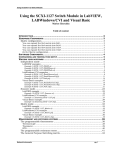Download A Quick Guide on How to Use the Fortran-to-Python - NO
Transcript
A Quick Guide on How to Use the Fortran-to-Python (F2PY) Module Magnus H-S Dahle February 2015 Abstract If you’re familiar with Python and Fortran, and wish to minimize reading: Linux users may jump to section 4.2, while Windows and MAC OS users to 4.1. You should in addition be aware that F2PY also works for wrapping C-code. 1 Introduction The choice of programming language can be extensively difficult, especially considering the computational effectiveness against implementation time and effort. While scripting languages like MATLAB and Python may provide intuitive code which is fast to implement, compiled languages like C/C++ and Fortran yield superior computational speed. Within this tutorial, we’ll show that it is in fact possible to obtain the very best of both worlds. At least to some extent. In the following example, we’ll make use of the Fortran to Python package F2PY , in which enables a Python script to directly call a readily compiled Fortran module. This is a powerful tool giving us the possibility for developing easy written code in Python, but leaving more computational demanding parts of our script to more capable Fortran routines. 2 Installation One should first note that F2PY is actually part of the NUMPY 1 (Numerical Python) package of Python. Thus, having successfully installed NUMPY should imply also having a functional F2PY -module. If your computer is running on a Linux distribution, using F2PY is rather straight forward and easy going, as Python with NUMPY is almost always integrated in the OS. Linux users may check if F2PY is already installed by just opening a terminal (by pressing [CTRL] + [ALT ] + [T ]) and then type the command f2py (with small letters). If it is installed, a short user manual will be printed in the terminal. If not, the terminal will complain that there exists no such command. For Linux users, F2PY is installed by installing NUMPY from official repositories. Evidently, this is also valid for computers running Windows or MAC OS! That is, download and install the NUMPY package. It is easy to find on the web, but if you’re having issues, you may want to take a look at the solved problem given by the following footnote2 . NOTE: If one struggles to make F2PY run correctly on one’s own computer, there are plenty of machines at the university (NTNU) running Linux Ubuntu, where NUMPY and F2PY are both installed! 3 When should You Use F2PY ? This is perhaps the ultimate question, and there is no definite answer. A good rule of thumb however, is to use F2PY , or compiled languages in general, when considering (nested) loops. Possibly the most typical example would be operations on elements in multidimensional matrices. Other good examples could be programs calculating integrals or conducting Monte Carlo Simulations. You might wonder if anyone has already made F2PY -modules before you, and the answer is most likely yes! Most of the functions and routines found in NUMPY and SCIPY are actually compiled Fortran routines which provides highly efficient and fast(!) solvers for multiple problems. Thus, we advice you to always check if one of these two modules already have a routine in which may be suitable for your problem. If not, then implement your solver in pure Python to see if efficiency really is an issue. If it is, then F2PY may possibly provide the best solution for your problem. 1 or more precisely: numpy.distutils. 2 http://scientificcomputingco.blogspot.no/2013/02/f2py-on-64bit-windows-python27.html 1 4 Usage and Syntax by a Marginal Working Example In the following, we present a short example on how to use the F2PY module. For details and references, we strongly encourage you to take a look at the module’s official documentation3 . The F2PY module effectively compiles and incorporates Fortran code into a new Python module4 , readily importable to any Python script. We will next give an working example and obviously, we’ll need some Fortran code! Furthermore, we’ll apply Fortran 90, and for simplicity, we’ll use the following, banal and trivial Fortran routine 1 ! This i s t h e c o n t e n t o f t h e f i l e : f o r t r a n f i l e n a m e . f 9 0 2 3 SUBROUTINE Fortran Sum (A, B, Su ) 4 5 r e a l ( 8 ) : : A, B, Su ! Real , d o u b l e p r e c i c i o n v a r i a b l e s 6 7 ! The F o r t r a n Compiler i g n o r e s a l l l i n e s s t a r t i n g w i t h ’ ! ’ 8 ! The ’ f 2 py ’ u t i l i z e s t h i s f a c t by d e f i n i n g i t s own s p e c i a l 9 ! command l i n e as ’ ! f 2 py ’ , su ch t h a t t h i s i s i g n o r e d by 10 ! Fortran , b u t used by Python t o d i s t i n g u i s h i n / o u t p u t v a r i a b l e s 11 ! N o t i c e t h e u s e o f s m a l l c a s e d l e t t e r s . . 12 13 ! f 2 p y i n t e n t ( i n ) a 14 ! f 2 p y i n t e n t ( i n ) b 15 ! f 2 p y i n t e n t ( o u t ) Su 16 17 Su = A + B 18 19 END SUBROUTINE NOTE: that older versions of fortran (e.g. 77), uses file extension .f, not .f90, but even more crucial; the comment-character may be different! For Fortran77, it is an upper case ’C’, while for more modern versions of Fortran (e.g. 90) it is an exclamation mark ’!’. This ultimately also affects the !f2py → Cf2py command. You may witness examples of this if you search for more tutorials elsewhere. Finally, we want to compile this Fortran Subroutine and incorporate it into a python module to be imported in a python script. • Create your Fortran file, fortran file name.f90. It may contain multiple subroutines. • Choose a name for the Python module you are about to create, chosen module name. • Create a directory in which you want to work in and move/copy-paste the Fortran file there. Linux users may skip the next section, and go straight to section 4.2 in which explaines a somewhat easier Linux-approach. 4.1 Creating the Python Module from Fortran Code - The General Method The following method uses/runs nothing but a pre-written Python script and is thus eligible for all users regardless of their Operating System. One needs the arbitrarily named Python script build f2py modules.py which is given below and uses numpy.distutils to generate a new Python module from the Fortran code file. 3 http://docs.scipy.org/doc/numpy-dev/f2py/">documentation 4 Equivalent to NUMPY , SciPy, etc. 2 1 2 # The c o n t e n t o f b u i l d f 2 p y m o d u l e s . py 3 4 from numpy . d i s t u t i l s . c o r e import E x t e n s i o n 5 6 e x t = E x t e n s i o n ( name = ’ chosen module name ’ , 7 sources = [ ’ fortran file name . f90 ’ ] ) 8 9 if name == ” m a i n ” : 10 from numpy . d i s t u t i l s . c o r e import s e t u p 11 s e t u p ( name = ’ f 2 p y e x a m p l e ’ , 12 ext modules = [ ext ] 13 ) Running this Python script will result in the creation of the new directory build/lib.linux-x86 64-3.4/, where you will find the newly generated file chosen module name.cpython-34m.so. This is a Python module, to be imported equivalently like any other module within a python script, e.g. NUMPY or SCIPY! 4.2 Creating the Python Module from Fortran Code - The Easy Life of the Linux User Having installed F2PY , you can call it directly from the terminal, w o r k i n g d i r e c t o r y % f 2 p y −c −m chosen module name f o r t r a n f i l e n a m e . f 9 0 which will create the file chosen module name.so. This is a Python module, to be imported equivalently like any other module within a python script, e.g. NUMPY or SCIPY! 4.3 How to Use the Module You’ve Just Created Move/copy-paste the Python module file you just created to a directory you wish to work in, Start a live Python console (or simply create a script) and import whatever modules you’d like, including your own self made. Print your self made module’s documentation to see if it was imported correctly. >>> import numpy >>> import chosen module name >>> print ( chosen module name . doc ) Which should result in, This module ’ chosen module name ’ i s auto−g e n e r a t e d with f 2 p y ( v e r s i o n : 2 ) . Functions : su = f o r t r a n s u m ( a , b ) . >>> NOTE: that in the process of creating the python module from the Fortran code, upper case letters are transformed to lower case. This is not that much of a big deal, however, you should note that Fortran is not case-sensitive. That is, variable/function names like aAA, aaa, AAA are equivalent and non-distinguishable. This is however not the case in Python. Nevertheless, the function may now be called similar to any other python function/routine 3 >>> a = numpy . l i n s p a c e ( 0 , 1 , 1 0 ) >>> A = chosen module name . f o r t r a n s u m ( 1 . 2 , 4 . 2 ) >>> print (A) 5.4 >>> Hot Insider Tip: If you’re planning on using F2PY quite a lot, you might end up with a large amount of self made Python modules. We therefore suggest that you create a permanent library directory to store all modules you create this way. Thus, you can make a static path thread to import all your glorious modules from, whenever you need them. This way, you’ll save a lot of space compared to having a copy of the module in every project you conduct. 5 Where to Go Next!? As a starter, try to implement your own modules, which may also include multiple subroutines! We would also like to encourage you to redo the example, but this time with the source code written in C instead of Fortran. This tutorial was meant to be as short as possible, and while we do not necessarily claim to have succeeded on this point, we have given a marginal working example but neglected much of F2PY ’s functionality and applications. Hence, we’d like encourage you to take greater look in its details and documentation! We suggest you to try to write a generic integration routine (in fortran), in which takes a general (one-dimensional) function and integration boundaries as arguments and returns the integral. Nested loops are known to be an Achilles heel for all scripting language. You can also take a look at this numerical integration example5 which explicity shows how powerful a tool F2PY can be, by reducing the total running time of a pure Python script by a factor of 300 by using F2PY. If you have any comments, suggestions or even corrections you wish to add, please feel free to send me an email, magnud(at)stud.ntnu.no or mhsd91(at)gmail.com. 5 http://folk.ntnu.no/magnud/Projects/F2PY_integration.html 4

















